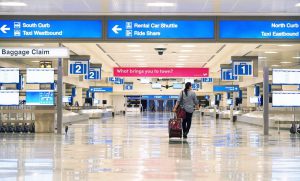MARCH 30, 2020

A lone traveler enters an empty baggage claim area in Terminal Four at Sky Harbor International Airport in Phoenix. Airlines are reducing flights due to the coronavirus COVID-19 outbreak.
The unemployment rate in the U.S. could reach a staggering 32.1% in the second quarter as 47 million workers are laid off amid the coronavirus outbreak, according to estimates published in a blog by the Federal Reserve Bank of St. Louis.
That would be the highest jobless rate on records dating to 1948 and easily top the 25% rate during the Great Depression.
“These are very large numbers by historical standards, but this is a rather unique shock that is unlike any other experienced by the U.S. economy in the last 100 years, “ St. Louis Fed economist Miguel Faria-e-Castro wrote in the blog.
Millions of Americans already have been laid off as states and localities shut down nonessential businesses and Americans avoid public gathering spots to contain the spread of the virus. About 3.3 million people filed for unemployment benefits for the first time during the week ending March 21, reflecting layoffs in the economy.
The latest unemployment estimate is even worse than the 30% jobless rate St. Louis Fed President James Bullard projected earlier in March.
Faria-e-Castro says he arrived at his figures by combining data in two other blogs by his colleagues at the St. Louis Fed. One estimates that 66.8 million Americans work in occupations at a high risk of a layoff, including sales, production and food preparation and services.
Another blog figures that 27.3 million workers are in occupations that require close proximity to other people, such as barbers, restaurant servers and flight attendants.
Since there’s a significant overlap between those two groups, Faria-e-Castro took the average of the two figures — 47 million, which equate a 32.1% unemployment rate.
Faria-e-Castro acknowledges his calculation doesn’t account for businesses who may send workers home with pay instead of laying them off and the effects of the recently passed stimulus bill, which provides loans or grants to fund many small business’s payroll and operating costs.
The total also doesn’t figure in that many workers may not even look for jobs, which would translate into a lower unemployment rate but no less pain for the jobless.
Courtesy/Source: USA Today










































































































